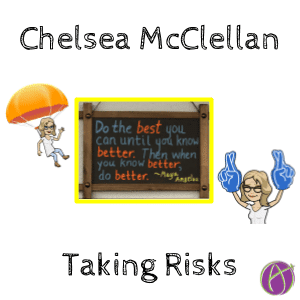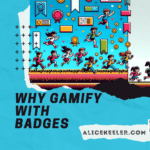Taking Risks
Guest blog post by math teacher Chelsea McClellan
This year, I took 3 big risks in the classroom. I wanted student feedback on these risks. As I loop with my 7th/8th grade students, it’s always fascinating to get their insights, which are rich in diversity and personalization, so that I can make adjustments for their next year with me. And they know I will adjust. They know I will change for them.
Risk 1: NO Traditional Assessments
Last year, students were given a Study Guide at the beginning of each week. Two lessons would proceed, there would be a period of collaborative study time, then the next day a 9 problem quiz. I would grade them that night (with copious feedback), give them back the next period (error analysis time given), then students had a week to retake the problems missed for full credit. I thought this was a very thoughtful system, allowing growth and ownership of learning. Wrong!
This year, I decided to eliminate these quizzes entirely. Instead, I use formative assessment including: 360 Degree Math, Quizziz (partner and individual), Open Middle Tasks, Problem-Based Lessons, Visual Patterns, and Khan Academy assignments for DOK 1 skill practice in class.
Why? Our district adopted NWEA. This test is given 3 times per year and takes 5 class periods each time it is given. The SBAC (State Test) is given once a year and also takes 5 class periods. That alone is 20 days of summative assessment. [tweet]I discovered that my students were spending over ¼ of their year taking a summative assessment. GROSS![/tweet]
Student Feedback:
“I like it better this year. I get to learn at my own pace. I don’t have to stress out about knowing it by the date of the test.”
“I agree, I would be so stressed out. Sometimes I didn’t understand yet, but I still had to take the quiz.”
“This year, we get to show you when we’re ready, when we’ve really learned it.”
“I feel like I have more time to collaborate and practice in class. I think I learn more this way.”
“When we use the mini-boards or 360 boards, you can see our mistakes and we can talk about them and fix them. You see what we know.”
Risk 2: No hard Due Dates/Full Credit for Revisions
Last year, I followed the school policy of 50% credit for late work. I was being a team player…or so I thought. Often, students never completed missing work or late assignments. And it was always the same students. If it was late, they knew it would only get 50%, so what was the point in continuing the learning?
This year, every assignment still has a due date, and I still update the gradebook each week and send home emails to communicate where students are in their learning, yet at ANY time, a student can complete/revise the assignment for full credit, multiple times. I give feedback, they revise. The learning continues. And guess what, only about 3-5 students per grading period (out of 100) end with a missing assignment or low score. Students who seemed satisfied with “good enough” now revise.
Student Feedback:
“I love this. I can complete assignments once I’ve actually learned it.”
“I’m so busy. Sometimes I’m not ready by the due date. But I know I will get to it, I will learn it.”
“I liked the structure of having fixed dates last year because everything stays organized.”
“I like the idea, and it’s much less stressful, but it made me more lazy.”
“Soft due dates allow me to procrastinate, so I do.”
“This year I keep revising until I get the highest score possible.”
“I didn’t fully understand it by the due date, so I worked on it over the weekend by choice, and got full credit.”
“With this system, I feel more motivated to improve my work.”
Risk 3: Use of a 4 point Rubric, no weighted grades
Last year, summative assessments were 60% and classwork was 40%. If a student had a higher percentage on assessments than classwork, I would let that be their report card grade since that’s more about mastery, right? Not for everyone.
This year, each assignment that I enter in the gradebook is scored using a 4 point rubric (see below). Students submit work, receive peer and/or teacher feedback and can revise it until they are satisfied with the score. This grading system is still in process. Any assignment that has a percent score (computer graded) is converted into a 4 point scale: 90-100% = 4, 80-89% = 3, 75-79% = 2.5, 70-74% =2, anything below is a 1 and obviously needs revision (for full credit).
Student Feedback:
“I like the rubric because we can choose what score we want to get.”
“I want the 4.”
“I like the 4 point rubric because I am able to revise as needed.”
“I like the rubric because we can be responsible for our own scores and if we don’t get the score we want, we can’t blame others, we can fix it.”
“If you don’t make mistakes, you can always explain what doesn’t work.”
“The only part I question is that to get the higher scores, you have to make/learn from mistakes. What if I don’t make any mistakes?”
That is a great comment. What if a student just “gets it?” They are still encouraged to give counter-examples, explanations of what and why some conjectures are not solutions. I feel this is as necessary as “getting it.” Students should be able to recognize and explain the patterns they see as they proceed through their thinking journey. (See Peer Feedback below.)
Risks and Rewards:
If students are feeling that they have more ownership of their learning, when and how, and they are experiencing less stress while learning more, then I am thrilled! I will continue to take risks as I learn more about best practices and the research of Jo Boaler. After all, #kidsdeserveit, right?







